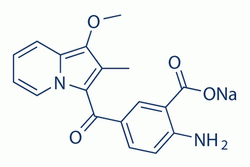| Cas No.: | 848318-25-2 |
| Chemical Name: | Benzoicacid,2-amino-5-[(1-methoxy-2-methyl-3-indolizinyl)carbonyl]-,sodiumsalt(1:1) |
| Synonyms: | SSR128129E; SSR 128129E; SSR-128129E. |
| SMILES: | O=C([O-])C1=CC(C(C2=C(C)C(OC)=C3C=CC=CN23)=O)=CC=C1N.[Na+] |
| Formula: | C18H15N2O4.Na |
| M.Wt: | 346.31 |
| Sotrage: | 2 years -20°C Powder, 2 weeks 4°C in DMSO, 6 months -80°C in DMSO |
| Description: | SSR128129E is an orally available and allosteric FGFR inhibitor with an IC50 of 1.9 μM for FGFR1. |
| In Vivo: | Oral delivery of SSR128129E (30 mg/kg/day, from day 3) inhibits growth of orthotopic Panc02 tumors by 44% and delays growth of Lewis lung carcinoma. oral SSR128129E (30 mg/kg/day, from day 5) reduces tumor size and weight by 53% and 40%, respectively. SSR128129E inhibits the growth of subcutaneous CT26 colon tumors by 34% and of the multidrug resistant MCF7/ADR breast cancer xenograft model by 40%. SSR128129E reduces tumor invasiveness and metastasis of Panc02 tumor cells to peritoneal lymph nodes[1]. |
| In Vitro: | SSR128129E inhibits FGF2-induced EC proliferation with an IC50 of 31±1.6 nM, migration with an IC50 of 15.2±4.5 nM, and lamellipodia formation in a dose dependent manner. SSR128129E inhibits responses mediated by FGFR1-4. For instance, SSR128129E blocks EC migration in response to FGF1, a ligand of FGFR1 and FGFR4, and capillary tube formation in response to FGF19, a ligand of FGFR4. Proliferation and migration of the murine pancreatic Panc02 tumor cell line in response to FGF7 are also blocked by SSR128129E, showing that SSR128129E inhibits FGFR subtypes of other species as well. SSR128129E blocks different FGFR subtypes in various cell lines with nanomolar potency[1]. |

 DC Chemicals' products qualify for U.S. tariff exemptions. We guarantee no price increases due to customs duties and maintain stable supply, continuing to deliver reliable research solutions to our American clients.
DC Chemicals' products qualify for U.S. tariff exemptions. We guarantee no price increases due to customs duties and maintain stable supply, continuing to deliver reliable research solutions to our American clients.





















